Landwards
The
professional journal for the Institution of Agricultural Engineers

In this issue...
People – Award winning engineer
Profession – The benefits of diversity
Practice – CPD
Technical – Keeping road legal


The

In this issue...
People – Award winning engineer
Profession – The benefits of diversity
Practice – CPD
Technical – Keeping road legal

4 Agricultural engineering news and views
Perspectives from the people and profession
8 From the CEO’s desk
The latest Institution activity
10 The President’s musings
On skills and professionalism
12Biosystems engineering
A review of some of the latest papers
16 EurAgEng
What is the European society?
18 Profession – Diversity in practice
A reflection from the Oxford Farming Conference
20 Profession –European manufacturers
A report from the CEMA conference
22 Practice – CPD Members give their perspectives
26 People – Young engineers
Harper Adams Engineering Society on its travels
28 People – Award winning engineer
European Award of Merit
30 Technical - Trailer braking
The current debate around tractors, trailers and road safety
34 The Douglas Bomford Trust New Year, new faces
36 Membership matters
The latest branch and membership activity
48 Research roundup
New and ongoing project updates
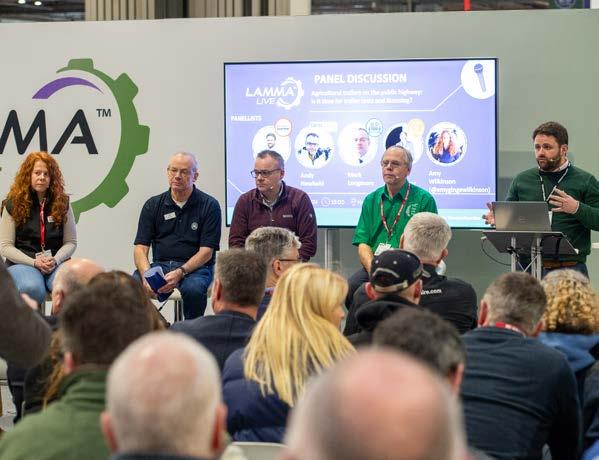
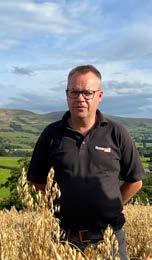
If you are an existing Associate Member you have the option to upgrade to Member grade providing you have completed 5 or more years in a relevant career.
However, if you prefer, you can remain as an Associate Member for as long as you wish.
For more information please see:
https://iagre.org/upload/1621421462.pdf
or contact Alison at:
membership@iagre.org
It’s been a busy start to 2024!
Whilst winter 23-24 will not go down in anyone’s books as anything other than awful (* other, more anglo-saxon descriptors are available), it has been a good time to reflect and catch up on CPD. Yours truly’s record was selected for random audit by the IAgrE recently and found to be of a suitable standard, phew. Have a look at the testimonials from p22 on the benefits of this.
Not only has attendance at several winter conferences, events and farm visits been in the diary, but I have been privileged to be appointed as Secretary General of the European Society of Agricultural Engineers (more of that on p16). I’m not resting on my laurels.
Elsewhere in Landwards (p30 Technical) there is a write up on the trailer safety panel discussion at LAMMA back in January, which generated a lively debate.
On the professional front we cover the benefits of diversity in farming, via the Oxford Farming Conference (p18) and have a look at the key European themes from the CEMA Conference back in November from p20.
I hope this makes for a stimulating read, and as always, I welcome your feedback.
andy@farm-smart.co.uk
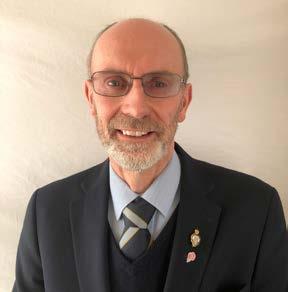
Holding back the floods: can we engineer a way out of this?
JaneRickson, PhD,
CEnv,HonFIAgrE, FHEA, Professor of Soil Erosion and Conservation Cranfield Soil, AgriFood and Biosciences and Honorary Fellow of the Institution of Agricultural Engineers asks can agricultural engineers help mitigate the damage caused by flooding?
This headline is taken from the Guardian newspaper (Saturday 27th January 2024). Parts of the country have been devastated - again - by flooding, causing damage to properties and livelihoods.
The article argues that increasing expenditure on physical flood defences such as the £11 million aluminium barrier system to protect the town of Bewdley, on the River Severn may not be cost-effective. Despite being designed and built to withstand exceptional events such as the ‘1 in 200 years’ storm, the exceptional rainfall, peak river flows and flooding associated with climate change mean “it is a matter of when, not if, the barriers are breached”. The situation is likely to get worse: The Centre for Ecology and Hydrology estimate flood peaks will rise by 15 – 25% over next 20 years.
The Guardian article quotes a retired Environment Agency employee: “We cannot engineer our way out of this. Raising existing defences
won’t be technically, financially or environmentally possible”.
But maybe we need a broader look at ‘engineering’ solutions? Specifically, agricultural engineering can have a really important role here. How we manage the rural landscape upstream of places vulnerable to flooding can help reduce the volume and speed of water flowing downstream. In these catchments, 85-90% of the land is down to agriculture or forestry.
Soil damage from harvesting and field operations when fields are too wet increases surface water runoff and risks of flooding. For example, winter cereal establishment in late autumn in South West England often results in damaged soil, with degraded structure and enhanced surface-water runoff found in three of every five cereal fields*. Better application of soil and water engineering principles, with real-time prediction of soil conditions and innovative machinery options, can
help. The Institution of Agricultural Engineers has made this point many times in relation to river catchments generally. Indeed, back in November 2019, the Institution of Agricultural Engineers issued a press release on how agricultural engineers can help mitigate the damage caused by floods.
Given that hydrological data shows that “no artificial defence will be enough to stop the water”, it is time to focus more on agricultural engineering to design, build and test better land management systems (including low-impact machinery, cover cropping, reduced tillage and controlled-traffic operations) that control flooding at its source.
Note:
* Palmer, R.C. and Smith, R.P. (2013), Soil structural degradation in SW England and its impact on surface-water runoff generation. Soil Use Management, 29: 567-575. https://doi.org/10.1111/sum.12068

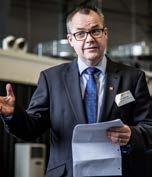
The European Society of Agricultural Engineers (EurAgEng) has appointed Andy Newbold as Secretary General to lead the society’s development as an international community of professional engineers.
Effective from January 2024, Andy’s role involves helping shape the future of agricultural engineering in Europe. He will encourage cooperation and collaboration between professional agricultural engineers at all levels across the region, academia, industry, and national member organisations.
Winner of the IAgrE Ivel Award was Kverneland for its PUDAMA which was presented by Charlie Nicklin, Chief Executive of the Institution of Agricultural Engineers (IAgrE). “This precise fertiliser spot applicator allows farmers to use less fertiliser whilst maintaining yields, and its these types of solutions the industry needs going forward to benefit both the farmer’s finances and the environment.”
Andy joins EurAgEng as an Honorary Fellow of the UK’s Institution of Agricultural Engineers (IAgrE), a Chartered Engineer with a career in agricultural machinery compliance, technical event organisation and publishing.
EurAgEng’s President Professor Dr Barbara Sturm said on his appointment “This role is vital for the future development of the Society and both the Executive Board and the Council are very excited about Andy’s appointment.
“His mix of practical agricultural engineering, coupled with event organisation at the highest level, and track record with technical publishing gives EurAgEng a real opportunity to raise its game.”
Andy lives in England’s North West, he is a former President of IAgrE, event manager for the UK’s ScotGrass and Tillage-Live working demonstrations, edits and publishes Tillage & Soils, Precise, Agrimachinerynews.com, Agrimachinery.trade and Landwards magazines. He helps run a small family upland farm on the western
fringes of the Yorkshire Dales National Park.
Reflecting on this new role Andy said “I am honoured to have been appointed and am looking forward to helping take the profession forwards.”
If you would like to work with EurAgEng don’t hesitate to contact Andy via secgen@eurageng.eu
EurAgEng was established in 1992 in a spirit of collaboration, to bring together those specialists of the sector that recognized the need to communicate knowledge and experience, to foster mutual understanding and to promote professionalism among National Societies of agricultural engineers in Europe, as well as among individuals.
The successful series of agricultural engineering conferences demonstrates the strong desire for mutual contact and exchange among agricultural engineers throughout Europe, seeking to meet the challenge of increasing the food supplies and resolving the diverse demands on the agricultural sector in industrialised nations.
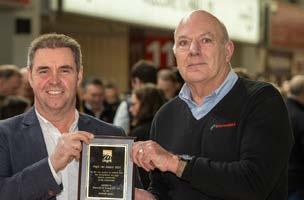
The company writes in LinkedIn –“Our technology delivered value at a profit, with customers waiting, but we could not secure the required investment to scale. We had a signed Term Sheet, but unfortunately the investment did not land before our runway ended.

We have created something remarkable in the last 6 years. We co-designed our service with farmers, successfully delivering their ‘Holy Grail’, a world first: grass weed detection at field scale. This went commercially live in September, with huge potential: UK blackgrass alone loses farmers £400 million each year. Service last season demonstrated up to 90% herbicide and 24% fertiliser savings.
We believe we developed something that will be a cornerstone of how farms are run in the future, but unfortunately with this attempt we were too early for the market. Our chapter in the fourth agricultural revolution is over. We hope we have inspired others to continue the mission.
As of the 1st February, Kroll has been appointed as administrators to sell the assets. We have worked with them to find potential acquirers, ideally to find a future for some of the team and the technology which continues to have a benefit to farmers, and the planet.
We would like to thank everyone who has supported us in our mission to make farming sustainable”.
IAgrE was heavily involved both in sponsoring awards at LAMMA, and with many of the award judges being members.

• Ieuan Evans from Mid Wales –inventor of the Smart Slurry Pump – has been named winner of the Young Engineer Award at LAMMA 2024
The idea for the Smart Slurry Pump came from ‘countless hours’ operating a tractor driven umbilical slurry pump on his family’s dairy farm in Aberystwyth, Wales. He developed a prototype as part of research towards his Masters in agricultural engineering at Harper Adams University. After graduating he took up a role as engineering and technical manager for Storth Machinery where he continued to develop the pump.
The Smart Slurry Pump is a real time telemetry system that monitors key information from a remote-controlled tractor and umbilical slurry pump, and then relays this information to the remote operator at the applicator end of the umbilical pipeline (dribble bar/ trailing shoe etc). By providing more information to the remote operator of the Smart Slurry Pump, the system provides several financial and environmental benefits. These include a reduced labour requirement, better
utilisation of the existing tractor fleet, increased fuel economy per m3 of slurry pumped and closer monitoring of pumping operations to prevent slurry bursts or leaks.
Ieuan said: “It is a brilliant feeling to be recognised within the industry. A lot of hard work over many years went into creating the Smart Slurry Pump, but the journey has really helped me progress my career in a short space of time.
“The project started during my time at Harper Adams, where a lot of the novel work was done, and I continued to develop it at Storth Machinery, where the full vision was realised. There is still lots of work to do though. We are aiming to increase the system’s monitoring capability to reassure the user that the pump is working as intended, as well as helping them to manage fuel efficiency and observe any anomalies.”
Presenting the award, Toby Whatley, Head of Machinery and Farm Technology at Farmers Guardian commended Ieuan’s perseverance. “We were impressed by your determination in developing the Smart Slurry Pump, seeking a solution right through from your education to your start in the industry.”

On a long, wet drive back from Chelmsford to Cheshire you can’t help gazing across the fields instead of looking where you should be going! What greets the eye is field after field with water lying everywhere. The ground seems to be just so wet now, but with spring on its way hopefully things should improve.
During a damp few days, in Sussex, Kent and Essex, I met several excellent groups of students and apprentices, with lecturers doing a great job producing our future technicians. The difference a good lecturer can make at a college is unmeasurable, it’s the staff that make colleges successful and inspire the students to go on and do great things. The land-based training and education sector desperately need more lecturers, especially from industry, but to do so they need to make it more attractive by pushing
up the benefits more and making it easier to get into by showing pathways and routes in. I’ll be interested to see how JCB get on with their Trainer Bootcamp, which seems a great initiative to try and get people into technical training. The sophistication in modern equipment and the level of change we’ll experience this decade, whether it’s hydrogen fuel cells or driverless tractors, will need highly skilled technicians to keep the wheels turning.
Whilst in the South East I attended the Doe show, which is of course run by Ernest Doe & Sons, CNH dealers and old home of the Doe Triple D tractor. It was great to see a couple of the Doe’s ploughing away in the background of the yard, which was proudly exhibiting the mighty new Case 715 Quadtrac and the New Holland CR11 combine. There is certainly no sign of equipment size stalling, confirmed whether you’re in Essex, the halls of Agritechnica in Hannover or our version, LAMMA in Birmingham. Whether its combines, foragers or tractors, acre eating performance is still a key objective. Will they continue to get bigger you may ask? Well, if we can maintain the land they travel on in a reasonable manner I see no reason why not; performance and efficiency has always ruled the roost, and the pressure to produce more from less isn’t going away.
For those lucky enough to attend Agritechnica, there was certainly plenty to see. Personally, I was very frustrated by a lot of the autonomous tractor tech on offer, or not, as it simply wasn’t available to buy, let alone use; one very large manufacturer even told me they had no plans for Europe, my response was of course a blunt reference to where they were actually exhibiting! Agritechnica does have a habit of leading you into a false world where hi-tech futuristic equipment is the norm, not necessarily what you can buy and use.

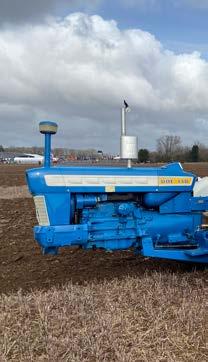
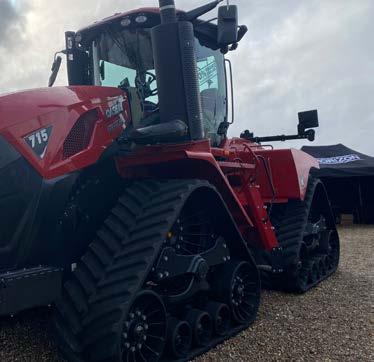
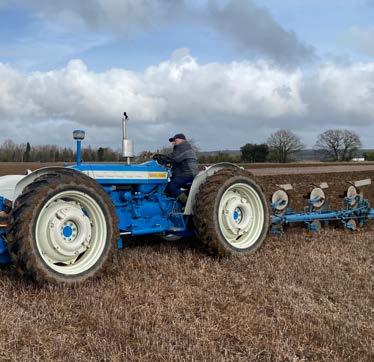
Jump forward to LAMMA in January and things are maybe a little more down to earth and less futuristic, but still big!6 I was honoured to be on the judging panel again this year for a few awards, we had some great entries and worthy winners that have been covered in the press in more detail. The winner of our Ivel Environmental Award was Kverneland with their Pudama precision fertiliser placement system, which significantly reduces fertiliser usage without effecting yield. I particularly like the Young Engineers award as it’s great to see engineers and entrepreneurs with innovative ideas coming through in the industry. This year it was won by IAgrE member Ieuan Evans from Storth machinery for his slurry pump telemetry system. His project, like many ideas was born from his own experience on the farm, which turned into a project undertaken at Harper Adams, and then supported by Storth as a commercial development.
On the subject of Harper, I presented to a number of final year students who were interested in progressing their EngTech registrations; a useful stepping stone for someone who’s long term goal is either IEng or CEng. The first couple of years of an accredited degree, such as a Harper BEng, will allow you to meet the academic requirements for EngTech, it’s then a case of meeting the competency requirements from your prior experience, work placements, etc. Coming out of university armed with EngTech registration will make your CV stand out from others, showing your commitment to your professional development and career; it may be the decider between you getting an interview and someone else not! Finally, many thanks for those that have paid their 2024 subscription and also a warm welcome to the many new members which have joined us this year, we hope you enjoy the content on offer.
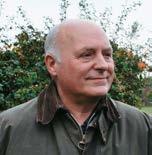

It was an honour to be involved in the judging of the Lamma 2024 Innovation Awards at the NEC in January.
I was particularly interested to see up close the technical innovations being developed by manufacturers which offer producers real and tangible benefits both with the efficiency and effectiveness of food production techniques. This drive for delivering more economic production has, in most cases, positive effects on the environment in their real-world applications which is also a bonus.
Having networked with many engineers and technicians throughout the day it was obvious to me that the “agricultural engineering skills requirement” is high and increasing. The need for a wider breadth of engineering skills is expanding, and the need to service, repair and maintain today’s equipment requires many more specialist engineers.
Excitingly there were many young people involved in the teams who helped develop these innovations and to keep on developing there must be a high level of training and professional standards from further education and beyond. To achieve this there needs to be an injection of funds and better paid inspirational teaching professionals who can inspire and encourage young people

to look at the many options available in our industry.
I would urge anyone who is reading this article and is not yet a member of the Institution of Agricultural Engineers to seriously consider joining and any business owner who employs technicians might consider a corporate membership
and encourage and/or subsidise their technicians to join us. The benefit of this will be that you will have access to our events which are a perfect opportunity to network with many members who are at the top of their specialism, and you will be able to develop skills, obtain professional qualifications and develop and maintain CPD in the process. There are many other benefits to joining the Institution so please visit our website
for further information or if you’ve already joined, tell a friend. This is the last of my Musings as President of the Institution before I hand over the role to Mark Moore at the forthcoming AGM in April. I want to thank the Secretariat for their work and support during my two years in office and hope that Mark finds the role as fulfilling and interesting as I have done.
Biosystems Engineering, owned by the IAgrE, and the official scientific journal of EurAgEng, is published monthly with occasional special issues.
Head to
https://www.sciencedirect.com/ journal/biosystems-engineering to view the full article list of the latest edition and
to find out more about depth and breadth of articles accepted for publication.
Reduced subscriptions are available to IAgrE members. Go to https://iagre.org/ biosystemsinformation for details of the preferential rates for both paper and electronic versions.
Over the past three months (November 2023 – January 2024), Biosystems Engineering has published 58 articles, which included three review articles and two short communications. The following three articles, one from each volume, have been chosen to illustrate the diversity of work in the journal.
Biosystems Engineering
Volume 235, November 2023,
Pages 202-214
Subcutaneous temperature monitoring through ear tag for heat stress detection in dairy cows
Hanwook Chung, Hien Vu, Younghyun Kim, Christopher Y. Choi
Department of Biological Systems Engineering and Department of Electrical and Computer Engineering, University of Wisconsin–Madison, 460 Henry Mall, Madison, WI 53706, USA
Highlights
• An ear tag device was developed to transmit body temperature wirelessly in real time.
• The subcutaneous ear base temperature readings were accurate under heat stress conditions.
• There were time-consistent lags between environmental and body temperature rises.
• Subcutaneous temperature could accurately predict core body temperature.
Heat stress remains one of the greatest threats to the economic viability of the dairy industry, especially for larger farms seeking to expand their operations in warm and hot regions. This study developed and tested a reliable and timely method to monitor the body temperatures of commercial dairy animals. The system measures a cow’s subcutaneous temperature in real-time by means of an injectable, passive RFID biosensor installed at the base of the ear. The temperature sensor wirelessly interacts with a compact, lightweight ear tag device that is operated by a wirelessly rechargeable battery. The ear tag is able to upload the subcutaneous ear-base temperature measurements to a decision support system. The lightweight and compact design of this ear tag was made possible by

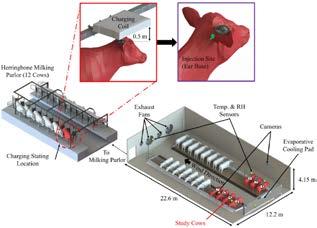
The senior editor of Biosystems Engineering, James Taylor has kindly summarised a selection of papers published in the past three issues, which will be of interest to IAgrE members.
recent advancements in wireless battery recharging capabilities and electronics that make power consumption more efficient. The research showed that the subcutaneous ear-base temperature (EBT) can synchronously follow the core body temperature (CBT) with, on average, the difference between the CBT and EBT being 0.68 ± 0.35 °C. Consequently, the CBT of a cow can be accurately predicted (mean error of 0.20°C) based on EBT, external environmental parameters, and the cow’s health information. These findings should enable dairy barn designers to develop and employ automated control-loop systems that utilise physiological feedback to improve management practices aimed at detecting heat stress and mitigating its effects in a timely manner, while minimising energy use. Given this study’s findings, ear-tag-based body temperature monitoring should become a crucial part of precision livestock agriculture, one that focuses on physiological feedback to manage an animal’s environment and health and maximise the animal’s well-being as well as productivity more efficiently.
Biosystems Engineering
Volume 236, December 2023, Pages 238-247
Mechanistic analysis of splash erosion on loess by single raindrop impact: Interaction of soil compaction, water content, and raindrop energy
Lei Lv, Yi Li, Chunmei Zhou
Key Laboratory of Coast Civil Structure Safety, Tianjin University, Tianjin, China School of Civil Engineering and Architecture, Wuhan Institute of Technology, Wuhan, Hubei, China
• Erosion mechanisms of compacted loess from a single-raindrop splash were studied.
• A critical point in water infiltration occurs during raindrop splash erosion.
• Variation of cohesiveness and internal friction were analysed at different water contents.
Theoretical and experimental studies
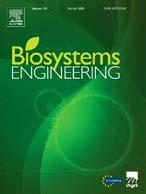
have demonstrated that splash erosion on agricultural land can affect agricultural production and the ecosystem. However, the splash erosion process mechanism of loess soil under the effects of a single raindrop remains unclear. Therefore, this study investigated the effects of single-raindrop splash erosion on the cohesion and internal friction angle of loess soil under multiple levels of compaction, water content and single-raindrop kinetic energies. The results showed that the depth and diameter of the crater produced were linearly related to both the raindrop kinetic energy and the loess compaction. The variation of crater depth was always lower than the variation of crater diameter, and the effect of the amount of raindrop energy on crater splash erosion was higher than the effect of compaction on crater splash erosion. Raindrops with higher kinetic energy have higher erosiveness, and this can shorten the ponding point time. When the water content is constant, the fitting curve of cohesion and compaction followed an



Padova, 35020, Legnaro, Italy
Research Centre for Viticulture and Enology, (CREA-VE), 31015, Conegliano, Italy
Laimburg Research Centre, Laimburg, 39051, Italy
Consorzio di Tutela del Conegliano
Valdobbiadene Prosecco DOCG, 31053, Pieve di Soligo, Italy
• Photogrammetry used to build digital twins of grapevine bunches.
• 2D and 3D descriptors for comparing intra-variety grapevine bunch morphology.
• Relationship modelled between 3D descriptors and grey mould infection on grape bunches
exponential relationship. The increment of cohesion decreased with increasing water content when the water content was lower than the optimum water content (12.7%) and increased with increasing water content when the water content was higher than the optimum water content. However, the increment of internal friction angle consistently increased with increasing water content, which is not affected by the optimum water content. This study could be a reference for soil erosion control in the Loess region of China.
Biosystems Engineering
Volume 237, January 2024, Pages 71-82
Digital Twins analysis as a tool to find new descriptors for grapevine bunch morphology categorisation and grey mould infection risk evaluation
Alessandro Zanchin, Marco Sozzi, Domenico Giora, Mahshid Kalantari, Nicola Belfiore, Josef Terleth, Diego Tomasi, Francesco Marinello
Department of Land Environment Agriculture and Forestry and Department of Agronomy, Food, Natural Resources, Animals, and Environment, University of
Botrytis cinerea is one of the most destructive diseases in viticulture, and grape bunch morphology plays a crucial role in grey mould infection. However, the common visual evaluation technique for assessing bunch compactness suffers from a lack of sensitivity and objectivity. This study proposed an investigation of the morphology of grapevine bunches using photogrammetry techniques for a whole Digital Twin (DT) reconstruction of grape bunches. Seventeen Pinot Gris and six Pinot Noir clones were considered. The grey mould severity was evaluated in the field. Fully ripened bunches (138) were gathered and then photographed at different angles. Digital twin reconstruction was carried out using the photogrammetry technique. Several 2D and 3D measures and indices were extracted from each digital twin. Principal component analysis and multiple linear regression models were then used to identify the descriptors most related to grey mould symptoms. Multiple linear regression (MLR) models were proposed per grapevine variety to find the correlation between grey mould severity and the descriptors from the 2D only (2D) and from both the 2D and 3D descriptor (3D). The 3D MLR showed higher performances than the 2D MLR. The results revealed that the most significant factors included the berries density, the estimated empty volume, and the bunch width. The proposed research demonstrated the relevance of cluster morphology to the susceptibility to grey mould infections. Future studies should validate the proposed models for the grapevine varieties and demonstrate the importance of the descriptors selected in this trial. Additionally, a completely automatic and unsupervised evaluation system based on artificial intelligence techniques could be developed based on this work. These results showed that digital twins are a suitable tool for estimating grey mould infection risks.
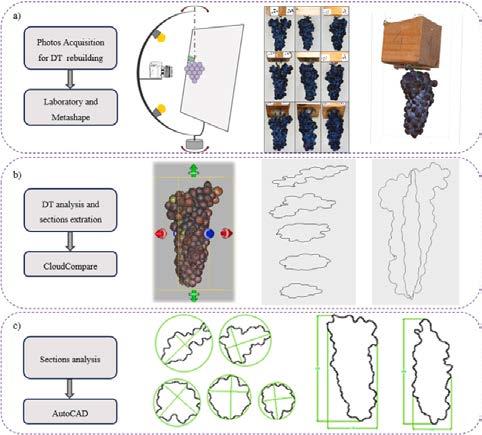


In the editor’s new role as Secretary General of the European Society of Agricultural Engineers, Andy Newbold (with help from previous SecGen Dave Tinker) reflects on what it’s all about.
EurAgEng (pronounced “You’re Agg Enj”) is the umbrella Society linking 18 National Societies of professional agricultural and biosystems engineers from European countries. It exists to promote the profession of Agricultural and Biosystems Engineering and the people who serve it.
Historically, the main role for EurAgEng was to ensure a conference took place every year to disseminate knowledge and, as important, to provide a sociable gathering for like-minded engineers to network.
In the odd years this is Land.Technik-AgEng, organised by the German VDI-MEG Society in Hannover and is part of the warm-up for the Agritechnica exhibition. This conference is a forum for agricultural engineering innovations covering power and field equipment. It is extremely popular, attracting over 1000 engineers from around the world, with the big global companies (John Deere, Claas, AGCO) each having hundreds of their staff looking for noteworthy ideas as well as describing their own latest developments. It is oversubscribed so submit paper abstracts and register in good time.
In the even years the conference moves around Europe between universities with agricultural engineering and biosystems departments. These conferences are smaller but cover all agricultural and biosystems topics:- crop storage;
soil management; livestock engineering etc.
EurAgEng helps promote and co-sponsor a variety of other conferences and seminars, mainly in Europe, but that are relevant to agricultural and biosystems engineering.
The Young Professionals Network is a relatively recent EurAgEng initiative intended to provide a platform for peer support for members in the early stages of their careers.
Directors from European agricultural engineering institutes used to meet to discuss possible projects etc. and became known as the European Network for Advanced Engineering in Agriculture and Environment (ENGAGE). At the time several European researchers were in the USA to complete PhD studies and attended the ASABE Conferences, enjoyed the knowledge exchange and networking and considered that Europe should do something similar. All-in-all when the UK’s National Institute of Agricultural Engineering (NIAE), later to be Silsoe Research Institute, organised a successful AgEng conference in Cambridge during 1984 as part of its 60th anniversary there was a strong suggestion that regular European conferences should be run. The first was in Amsterdam in 1986 and the first President, Francis Sevila appointed in 1992/3, and so EurAgEng was created with the JAER (later Biosystems Engineering)
adopted as the official scientific journal.
From the history it will be clear that the UK was a strong supporter of EurAgEng, even before it started! Of the four Secretary Generals three, including Dave Tinker and Andy Newbold have been British along with Presidents and members of Executive. Brits have appeared strongly as Award of Merit winners with Ray Clay (JCB Fastrac), Paul Miller (Silsoe Spray Applications Unit), Dick Godwin (Harper Adams University) and most recently Tim Chamen (CTF Europe) all award winners. EurAgEng values commercial engineers, and ensures that suitable representatives are on the Executive, as well as those with a more academic background.
Networking across a wide range of agricultural engineering topics is important. Socialising, discussing common interests and getting to know professional colleagues is the norm. It is also the best way to get involved in the multitude of research and development projects, especially now that the UK is back in the Horizon programme. Although somewhat convoluted to follow Horizon, EIT and other programmes are not only for academics to collaborate but also have platforms and calls, like those of Innovate UK, for business partners (including SMEs) to lead and collaborate and use the resources of academics to help with the R&D before commercialising the results.
The next Conference is at Athens University 1-3 July 2024. Further info at https://eurageng.eu/events/ageng-2024
The discount for EurAgEng members to attend a conference easily outweighs the membership subscription!
We look forward to seeing you at a future Conference.
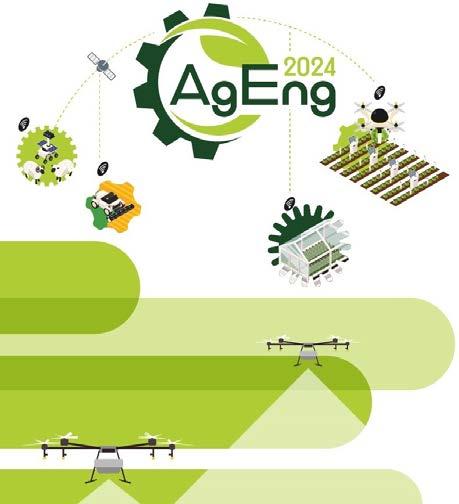

This session looked both globally and locally at how diversity is shaping productive farming and changing lives.
Dr Diana Onyango works with FarmAfrica, based in Nairobi, Kenya and opened with discussing the challenges they face with underperforming agriculture,
degrading natural resources and poor market access. FarmAfrica consequently works in agriculture, environment and market engagement.
Firstly, they are helping diversify smallholder farming with regenerative agriculture via crop rotation, intercropping and crop diversity.
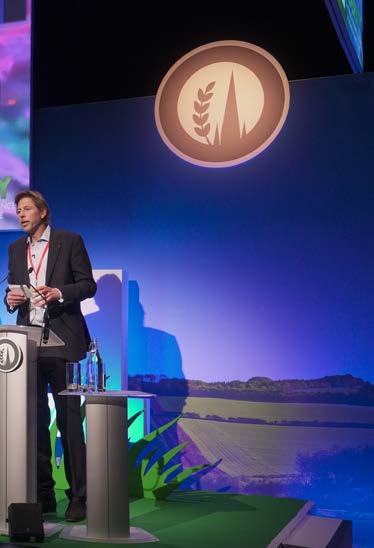
Working on Livestock diversity with both mixed farming and breed diversity alongside developing agroforestry and biodiversity through tree planting, beneficial insects and pollinators.
Beyond the farmgate their approach includes market diversification to help farmers develop diverse income streams and improve market access and with environmental conservation they focus on ecosystem services and water management.
FarmAfrica has a strong gender and social inclusion programme based on gender-responsive design. Examples include helping youth and women coffee farmers in Uganda, empowering Tanzanian women sunflower farmers and supporting women adapt to climate change in Ethiopia.
In summary delivering diversity in smallholder farming practices, crops, livestock, income sources and knowledge sharing networks. Next up local farmer Andy Cato from
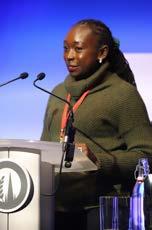
Wildfarmed took delegates on his route to including diversity in his crops and farming.
He considered how to bring diversity into existing systems, by maintaining diverse plant populations for as long as possible.
“I became obsessed with not ploughing up, but realised planting a grass into another grass didn’t work, but diversity did work”. Andy said.
Taking the classic three sisters seed blend of maize, beans and squashes, which performed better and has done for indigenous populations worldwide for millennia.
He found different crops delivered different rooting depths to encourage ‘spongier’ soils to handle rain fall events and harvest nutrients. In practice he mixed beans, rapeseed and oats with the limespreader and harrowed this mix in to produce a successful crop.
Wild farmers have about 90 growers and 20 customers “using The power of plant diversity in cropping systems”.
The take home from Andy was “Diversity is natures organising principle”.
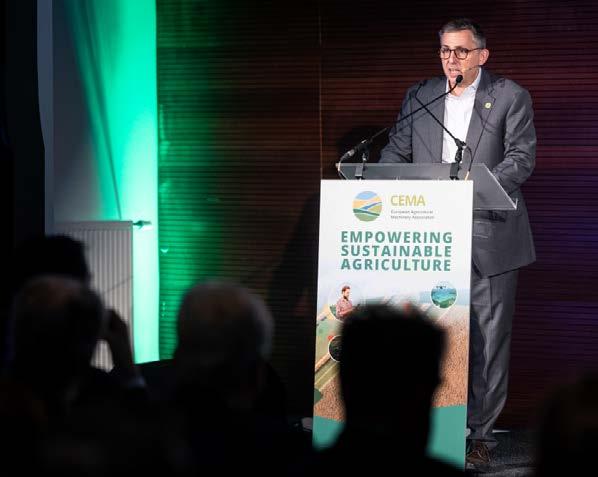
A “summit” was the right description for a high-level meeting in Brussels, held in late October and organised by the European Agricultural Machinery Association (CEMA). The theme was “Empowering Sustainable Agriculture”. Mark Kibblewhite reports.
Among the 160 participants from industry, the European institutions, academia, and stakeholder groups, were IAgrE Fellows Mark Kibblewhite (MK Soil Science) and Mark Moore (AGCO).
The agricultural machinery industry was represented by CEMA President Thierry Krier (CEO and President of KUHN Group), Carlo Lambro from CNH Industrial, Walter Wagner from AGCO/Fendt and Mark von Pentz from John Deere.
There was an emphasis on the need for new policy and European legislation to support rapid innovation. The context is the strong expectations being placed
on the agriculture sector, to make rapid strides towards the European Union’s Green Deal and goals, such as those for net zero and the circular economy, as well as implementing developments relating to the Common Agricultural Policy. An impressive line-up of European Parliamentarians and senior European Commission officials were given a clear message: “Machinery manufacturers listen to and work alongside farmers daily to provide them with tailor-made technologies to make their farming practices more sustainable with the use of technological solutions. These solutions are adapted and customized to the needs of the farmers, who are varied and diverse, reflecting the diversity in European farming. For manufacturers to serve farmers, specific legislation needs to be put in place, as one-size does not fit-all in this case.” The plea from
the sector was for ongoing strategic dialogue to avoid polarised positions.
The potential for digital innovation was underlined by Maciej Golubiewski, Head of the Cabinet of European Commissioner for Agriculture. “Digital solutions,” he said, “can help us reinforce the competitiveness of European agriculture while strengthening its resilience”, while putting at the centre the importance of scalability and user-oriented innovations. This focus aligns with the wider European Commission’s prioritisation of digital strategy.
The presentations and discussions on energy options for agriculture were informative. There appeared to be some consensus that the future was threefold: electric power for smaller machinery, biomethane for the
mid-range, and hydrogen for the larger, high work rate equipment where high infrastructure costs can be justified. All of these were represented in the “Innovation Village”, including CNH’s biogas development and JCB’s hydrogen engine. However, this consensus was not total with Mark von Pentz from John Deere arguing for alternative liquid fuels as a more neutral technology approach.
It was revealing to be part of the sector’s European summit. Their challenges are driven by ambitious European Commission goals. These may be demanding, but they are also very progressive and backed by huge public investment. Here in the United Kingdom the direction is less clear and there is definite risk of falling behind our peers.

Continuing Professional Development (CPD) is something that seems to strike fear into the hearts of IAgrE members, which is a shame as it is a very useful practice that enhances every aspect of your professional life. CPD is sometimes referred to as lifelong learning , this describes it very well. Skills are developed as we progress through our careers, so we all do CPD without really realising it. IAgrE’s own Sarah McLeod from the Secretariat gives some thoughts.
CPD does not need to be a formal training experience but can be some Google research, some YouTube
How To’s, reading journals and articles that link to your profession, all are useful and valid CPD. As an Institution we ask our members to keep up to date as part of their
profession and we carry out a randomised CPD Sample Review annually. Don’t panic if you receive a request this year, ring me for a chat and I’ll be happy to assist. We have several tools to help you, including our App.
Several early career members have contributed their experience of CPD and it is encouraging to see that they are already in the habit of recording activities and viewing experiences as learning opportunities.
As a recent graduate, I have found that doing my continuous professional development has complemented the start of my career journey. If it wasn’t for CPD, I wouldn’t have a record of my learning after leaving university. It gives me the chance to structure and review my out-of-work learning and encourages me to invest in improving my agricultural engineering knowledge in my free time when I could easily get distracted by less productive things (like my phone!). It has enabled me to strengthen my CV and was really useful at my recent job interview.
Lots of the activities I am doing anyway, but by logging it on CPD I have to reflect on the experience and note the benefits. It also acts as a learning tracker so I can look back at what I have done which I otherwise wouldn’t easily be able to access.
It is also a motivator for attending events and taking learning opportunities. If I know I am being awarded with CPD points, then I am more inclined to invest my time in these opportunities. This has resulted in me watching lectures both relevant to my career and not. I have learned a variety of things from how other manufacturers structure their training, through to the robotics in a vineyard. I am much more likely to attend events and actively look for things to do related to my field such as manufacturer factories, and university robotic department tours.
From watching the videos and going on these trips, I gain valuable understanding of the industry and build up my connections which is a huge benefit as I am still starting out. In addition to this, I have a broader range of knowledge to share and for use in discussions with colleagues, customers and anyone else I come into contact with in and outside of agricultural engineering.
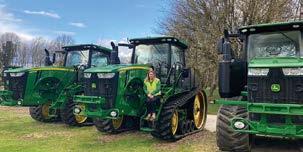

Currently working in Australia as a product specialist for CLAAS LEXION combine harvesters, and a demonstrator for AgXeed autonomous solutions for Landpower Group/CLAAS Harvest Centre. I am involved with demonstration, optimisation, sales support, training and diagnostics for LEXION harvesters and the AgXeed AgBot autonomous tractor. We have just completed the largest demonstration campaign ever undertaken for LEXION harvesters in Australia, and following this will be travelling Australia on the first ever
demonstration campaign of the AgXeed AgBot 5.115T2 autonomous tractor.
CPD is important to me at this stage in my career as I would like to become a chartered engineer in the future, and I know an accurate record of my development will be key to securing this. I use the IAgrE app on my phone to record my CPD, and I try to do it ‘live’ so I don’t forget! I’m sure I’m not the only person who has been guilty of doing plenty of CPD but forgetting to record it.
I am currently applying for EngTech, and the CPD record I have documented will be helpful in this process. However, I wish I’d started using the IAgrE app sooner, as I have had to fill in some blanks in my CPD record from my diary which has been time consuming!
As I am currently living in Australia, I try to catch to online IAgrE events when my schedule allows but it will be nice to be able to attend events in person when I return to the UK.
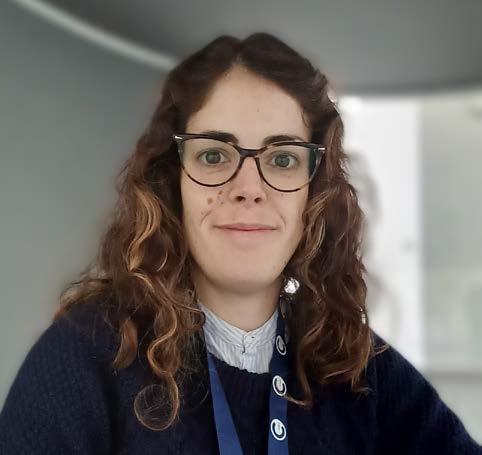
At first, it is hard to see the benefit of keeping a record of all the professional events, activities, training courses that you take part until you do it. It was only when I started adding my CPD record in MyCareerPath, a service that is included in the IAgrE membership, that I realised how much value this exercise can add to my career. When I first created my CPD, I had to look back six months or so, going through my calendar and thinking of what was relevant to be added. Since
then, I am getting into the habit of adding an entry soon after I have finished the activity or course, which takes one minute, and it is really easy.
I find completing my CPD is a very useful exercise, because it makes me remember the event and think about why it was useful for my career and what did I learn. Besides, keeping a CPD record is helping me identify what are the areas where I have gained more knowledge or
developed my skills further and what are the areas where there is room for improvement, and where I think I should concentrate future efforts. Keeping a CPD record has the additional benefit that the information is readily available and accessible anytime you need it. I have recently downloaded copies to support my application to become a Chartered Environmentalist with IAgrE, which I completed successfully in December 2023.

For me personally, CPD is an excellent way of tracking different things I have learnt and experienced. For example the technical presentations held at the Wrekin Branch, some of which are of great interest to me and keeping a log of these things are useful for future dates when I may need to look back at something of which was specifically mentioned / discussed. In a growing career, almost every
individual will benefit from CPD, and the different benefits that come from it. The activities that gain you CPD points are beneficial to both individuals and groups of people working within a team on a specific area or topic. Having an up to date CPD record will be very useful when applying for jobs at the end of my course.
I personally try to attend 75% of
events that the Institution and partners put on, whether they qualify for CPD points or not, as not only is it usually something to learn about, but also a great opportunity to network with industrial partners, more experienced members and students alike from different organisations. It is always good to share experiences, opportunities and ideas whether it’s personal or for the future of a company / institution.
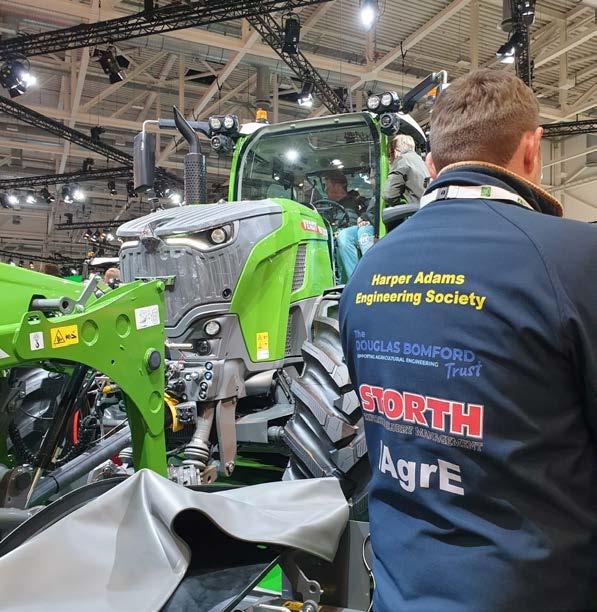
“Agritechnica is on another level”
With 18 exhibition halls spread over 320,000 square metres, Agritechnica gathers thousands of exhibitors and visitors from all around the world. It displays the best of past, present, and future agricultural technology and machinery, a show for all to enjoy, like no other. Rhodri Williams reports on the Harper Adams Engineering Society visit in November.
The trip was open to all students and staff of Harper Adams University, with predominantly 4th year Engineering and Agricultural students attending. Several 2nd year students also made up the 20 students, with other courses such as Real Estate who have taken an interest in the machinery and future farming side of their course.
The group of 20 departed early hours of Wednesday 15th November in convoy heading for Stansted Airport. They returned to Harper Campus late afternoon on Saturday 18th November. Although only 4 days away, a massive amount was seen, of the event, Hamburg City, local culture, and nightlife! Engineering society comments: “The best part of the trip was the number of brands showing off their new releases, concepts, and future for engineering. The nightlife was amazing with some really good bars and markets to see, and the beer was spot on.”
“‘I wanted to go to Agritechnica as I have an interest in alternative
being released/showcased. The highlight of the show was the number of electric tractors on display; Fendt e100 Vario, TAFE E30, Monarch MK-V, New Holland T4 Electric etc.”
“The AgriTechnica trip was absolutely worthwhile, the scale of the show amazed me and there were plenty of unique pieces of kit that you don’t get to see in the UK. Plus, the beer, food, and folks made it a great social trip too.”
“It was interesting to see all the new machinery and how different the global agricultural machinery market is from the UK. I enjoyed meeting new people to experience Agritechnica with.”
As the testimonials show, Agritechnica is on another level, crushing all expectations we had from shows such as Lamma. The scale of the event, with the variety of machines from classic tractors to machines that will shape the future of agriculture and sustainable precision farming.
tourist activities, such as the Ports of Hamburg which have a crucial part in the history for Hamburg and Northern Germany. A personal favourite for myself was the German culture and the food and drink, Schnitzel and BitBurger Beer is a combination I think most people should be exposed to at least once in their life!
So, after lots of researching, lots of exploring, immense amounts of networking on behalf of personal and professional needs, and a small bit of British dad dancing, all members had a brilliant time, and now the planning begins for our next event.
A massive thank you to our society Sponsors for the year including IAgrE, Storth, Lely, and the Douglas Bomford Trust, for the funding that keeps the society’s wheels turning.
A special thank you again to the Douglas Bomford Trust who provided extra funding for the trip to subsidise ticket costs for our members,

In November 2023 at the LAND.TECHNIK-AgEng conference in Hanover, Germany, the EurAgEng Award of Merit – Innovation into Practice was awarded to Dr Tim Chamen for developing and promoting controlled traffic farming (CTF) as a practical farm-scale tool for avoiding compaction damage to soils.
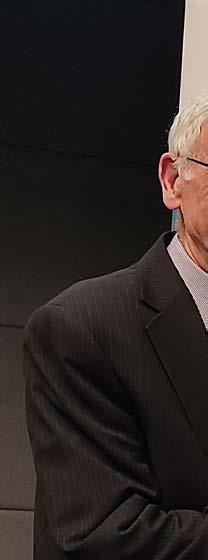
The EurAgEng Award of Merit –Innovation into Practice is granted to an individual for his or her major international contribution to commercial practice and engineering innovation for the benefit of agriculture, environment, industry and/or the rural sector in Europe.
Tim has more than four decades of involvement in applied research covering aspects of soil tillage, soil compaction and equipment design and development with much of it particularly targeted at ways of
avoiding compaction. This was initially through a 25-year research and development career at Silsoe Research Institute leading to Dr Chamen running a project to develop a 12m wide experimental tractor before he left in 1996.
Since then, he has worked independently for a range of organizations including machinery manufacturers, the EU and other public and private funders and organizations, but always with the
thread of avoiding compaction damage to soils. Following an increased demand for his expertise, he established CTF (Europe) Ltd in 2007. It was Dr Chamen’s work, and his active personal advocacy, that enabled and supported this phenomenal network of researchers and practitioners from all around the world to investigate and implement CTF systems.
Whilst researchers have investigated impacts on soils and the wider
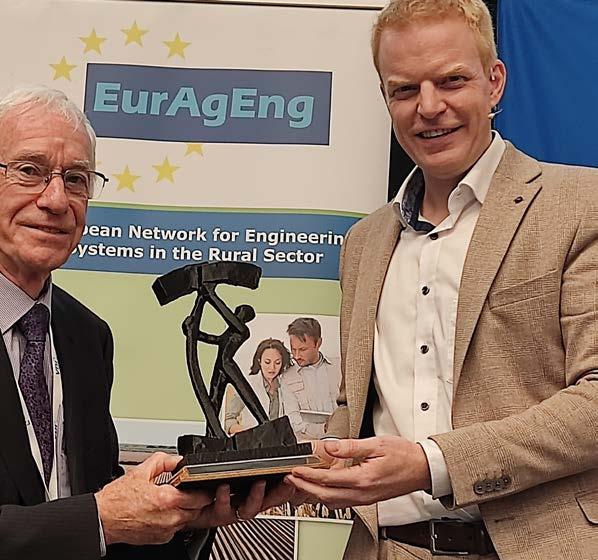
environment, often using non-standard machinery systems, such as gantries, to obtain research results, Dr Chamen’s focus was resolutely on ensuring that the benefits seen in the research were able to be adapted to practical systems and readily transferred to commercial farms. He therefore deliberately sought to maintain a boot in both camps and to provide a bridge to transfer and translate research information to farmers and explain the issues facing farmers to researchers. This approach has
supported effective research in practice as well as implementation by farmers and equipment suppliers.
Dr Chamen’s contributions to the role that CTF has to play are manifold in showing reduced compaction and combining this with the associated reduction in input costs for time, machinery, and fuel while improving crop production and so increasing profit. Dr Chamen has ensured that there is a sound scientific underpinning to the technique and has thought through various
CTF techniques so that CTF is practical and that farmers will enthusiastically adopt it when they decide that their equipment and farming system can be repositioned for economic and environmental advantages. Without his enthusiasm, passion and inspiration, there would not be Controlled Traffic Farming in practical use at so many farms and fields across Europe.

Technology, training and testing were key themes of a LAMMA Live panel discussion on modern farm machinery and the related legislation.
The discussion centred on whether the technology has out-stripped legislation, and also whether workers need more training and testing to operate machines that are bigger, faster and heavier than their predecessors.
It also considered the issue of how those farm vehicles co-exist with the public on ever-busier roads.
On the technology issue, Andy Newbold summed the situation up: “I have a feeling that the technology
has moved on but the legislation has not.
“Tractors are bigger and faster and trailers are bigger and capable of carrying more. Yet we still have the same competence obligations on the driver, and there are a lot more cars on the road now”.
Toby Whatley, technology editor for Farmers Guardian, agreed, pointing out that many of the rules date from the 1970/80s.
Since then, tractor and trailer weights had grown, as had working speeds, especially on the road, although brakes had also improved to enable this.
For the future, he suggests manufacturers need to find ways of raising weights and capacities safely.
Mark Longmore, from BPM which makes axles and suspensions, suggested that farming might consider the commercial transport
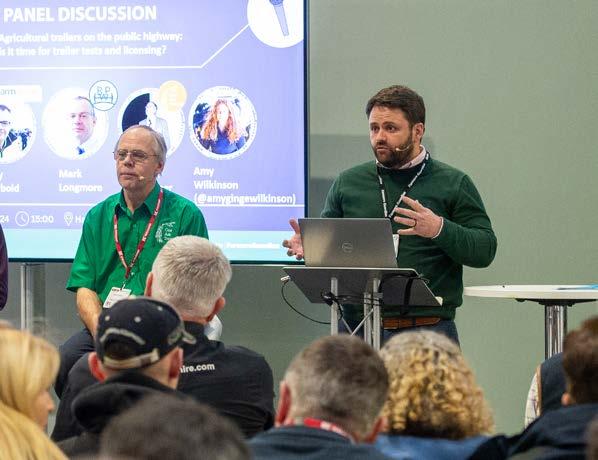
world, where trailers undertake a rolling brakes test once every six weeks.
He wondered whether – in future - farm trailers might face increased testing, maybe once every 12 weeks or six months, according to how frequently they were used on the road.
Rules are reasonable
Mike Sumner, representing the National Association of Agricultural Contractors, said professional contractors, whose equipment would be expected to complete a lot of road miles, would be happy to accept reasonable rules:
“They are already operating in a professional manner”. The discussion moved on to the
need for additional testing for operators with the idea of an intermediate test – tougher than the standard test for driving a car but not as exacting as the HGV test – causing extended debate.
Mr Sumner feels an interim test could prove effective, pointing out that the existing HGV qualifications involved a significant outlay on training and testing.
Commercial HGV drivers are subject to both driving hours and tachograph rules.
Other countries already operate a graduated licensing system, Andy Newbold pointed out.
In Germany if you hold a basic driving licence you are restricted to
driving farm vehicles at 40kph on the road.
But those who gain an additional driving qualification are permitted to travel at 55kph.
Lancashire farmer Amy Wilkinson, who said she commented as both machine operator and employer, believes that latter role gives her specific responsibilities.
She says any young operator joining her family’s business would initially be restricted to working in the farmyard until the family was satisfied with their skill level:
“They may be legally allowed to drive on the road but I would not
let them do it until I was satisfied on the issue”.
But young people don’t have the same ‘on the job’ learning opportunity their predecessors had:
“There are no small tractors out there for them to learn on. They are sitting on a 200hp – 350hp tractor from the start.
“There is no longer that pathway on which they can develop confidence so they are safe before they start operating big kit”.
Training is key
Mike Sumner agreed, and suggested a solution:
“The only way forward is through training. We can’t just let them loose. They all need to be trained to a competent level”.
One issue he sees is that different people’s view of what counts as an adequate level of training will vary. In a wider discussion that followed, audience member Matt Redman suggested the duty lay with employers:
“They have the responsibility to ensure operators are safe and competent to drive the size and speed of machine; that they are working sensible hours and getting sufficient breaks.
“You don’t need a license for that. That is down to training and the mindset of people in the industry. We should use the licensing we have already got.
“And we need to deal with the big issue that current legislation on weights and speeds is way out of kilter with what we need now”.

He believes the industry would be better off finding ways of creating openings for young people rather than a licensing system which would give people a headache.
On the subject of machine testing, Toby Whatley says any test should cover both tractor and the trailer, especially if the trailer was relying on the tractor’s hydraulics for braking:
“If the machine supplying the air or oil flow to the trailer isn’t working properly then you are entirely reliant on the trailer’s braking capacity”.
He worries that some farmers are already breaking the law, and
suggests they may find they have voided their insurance if they have an accident.
Amy wondered what the public might think of the current situation:
“I think the public would be shocked if they knew tractors don’t need MOTs and trailers leave the factory without having their brakes tested”. But she wondered whether testing machines that never leave the farm itself was necessary, although other contributors suggested it should be as it might prevent accidents.
Mike Sumner suggested there could be different testing regimes enforced according to the weight and working

speed of the tractors and trailers:
“If you are just working around the farmyard and under 25kph then the trailer might be tested every five years; if it will be used at up to 40kph and going on the road then test every two years.
“But if it’s going over 40kph and on the road commercially then the testing requirement could be annual”.
With many farm trailers being altered during their working life, their status also caused discussion. Toby Whatley pointed out that if a commercial road trailer was converted to farm use it would
still be covered by commercial trailer regulations.
And Mike Sumner reminded the audience that the same applied to a 3.5t trailer being towed behind a pick-up rated for 2.7t: “It’s not a compatible combination”.
Andy Newbold explained to the audience that they can ‘plate’ a trailer themselves: “Self-certification is possible, but only if you have the correct competence”.
Mike Longmore reminded anyone amending a trailer that they would have to re-do the brake calculations, to which Mike Sumner added:
“If you use an agricultural trailer for commercial purposes you cannot
exceed 40kph and you need a tachograph.
“Even if you don’t exceed 40kph you will need to record travelling hours”. Summing up the session, Toby Whatley said:
“Farmers don’t want to break the law but are being pushed to be efficient.
“We want a level of professionalism and we need to think about training rather than licenses. We need to get people who are professional and competent.
Welcome to my first article as the new Technical Secretary for the Douglas Bomford Trust. I will use this as an opportunity to update you on the changes that took place at the AGM held on 21st November 2023. Firstly, the Trust welcomed two new trustees, Julia Lucas and Jane Rickson.
Family representative
Julia is a Chartered Accountant and honoured to be a Bomford Family Representative on the Board. Julia is eldest daughter of John Fox, one of

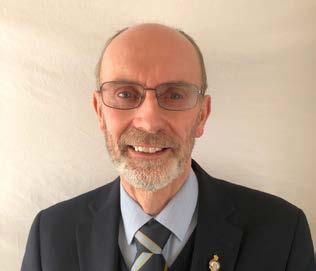
the founder trustees. Douglas Bomford was John’s boss and were great friends. Douglas was a surrogate grandfather to Julia and her sisters and he left Julia his pond yacht, Spray, in his will.
Julia has had many roles as a non-executive director and charity trustee over her career, including being an independent member of British Wool, and a trustee of the Stratford Town Trust, an ancient grant making charity.
Julia says “The DBT has a fantastic track record for supporting young agricultural engineers and expanding the understanding of agricultural practice over many years, collaborating with key institutions and experts. I’m delighted to be able to play a part in seeing it on the next phase of its journey. I’m not an engineer but I do know what needs to be done to nourish charities and enable them to deliver their objectives and that’s what I’ll be supporting the DBT to continue to do, to the best of my ability”.
Many of you will already know Jane from her time as President of the IAgrE (2018 - 2020. Jane is an IAgrE Honorary Fellow, Professor of Soil Erosion and Conservation at Cranfield Soil and Agrifood Institute,
Cranfield University, and was honoured with a Top 50 Women in Engineering Award from the Women’s Engineering Society in 2021.
Jane’s work has focused on the role of soil and water engineering to deliver ecosystems goods and services, including water regulation, agricultural production and carbon storage using transdisciplinary skills to integrate engineering with economics and social sciences. Her research also

includes engineering the landscape to increase carbon sequestration and storage to help reduce greenhouse gas emissions. She has shown that adapting to extreme weather events associated with climate change is possible by working with farmers to design and test field engineering practices that can mitigate soil and water losses, such as the use of conservation tillage, grass waterways and field buffer strips. Other research has tested different soil cultivation equipment to improve soil health and crop growth, such as a project on regenerative agriculture in potato production with partners including PepsiCo and McCains. She is able to replicate real life field conditions in cutting-edge pilot scale laboratory facilities that Jane helped to design and build at Cranfield. Jane is an inspiration to soil scientists and land-based engineers across the world. Jane acts as a mentor for other women, especially young female researchers, and engages in outreach activities that encourage girls to take up science, technology, engineering and maths (STEM) through her links with local primary schools and media work.
Paul Miller (seated bottom front right), Director of Silsoe Spray Applications Unit, became an Emeritus Trustee. Paul has been both a DBT Trustee, and its Technical Secretary. Paul received the EurAgEng Award of Merit for Scientific Understanding, and was elected a Fellow of the Royal Academy of Engineering in 2016. Paul has recently been appointed a Visiting Professor at Lincoln University.
And goodbye to:
Alan Plom, (seated bottom front left), retired as DBT Technical Secretary (2017 – 2023). Alan was with the HSE for 32 years, and was Head of Safety Section in HSE’s Agriculture & Food Sector where he led nationally on safety issues in agriculture and the land-based industries. At the AGM, the Board presented Alan with a gift as a thank you for all his hard work over the past 6 years. Alan, hopefully, you can now find more time to play your drums.
Finally, I was appointed as the new Technical Secretary. After 34 years full time at Harper Adams University, I have now gone part time. I am an ex-DBT Trustee (2012 – 2018). It is an honour and a privilege to be asked to be the new Technical Secretary. I hope that I can make a good a job as previous post holders.
For further information, see the Trust’s website:
www.dbt.org.uk
or contact the Secretary
David White via:
enquiries@dbt.org.uk
You can also follow:
@BomfordTrust
on Twitter and on LinkedIn, for news of interesting events, opportunities, or developments.
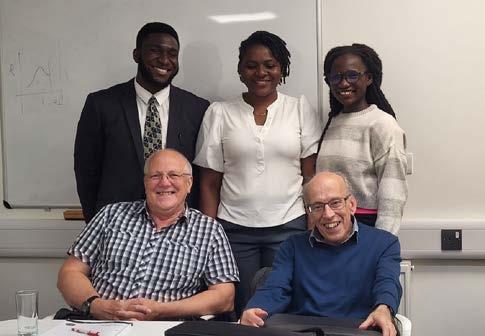
Reducing machinery costs in combinable crop production in Co Down
Reportby
Terence ChambersThe topic at a recent IAgrE Northern Ireland branch meeting was “Reducing machinery costs in combinable crop production”. The guest speaker was Mr Iain McMordie, a cereal grower, based in the Downpatrick area of Co.Down, who described his experience in controlling his mechanisation costs by his choice and use of farm machinery for combinable crops husbandry. His description of the evolution of the machinery types and sizes from those used on his home farm reminded us of the steady evolution of crop technology and methods.
Iain grew up on the family farm and went on to graduate with an Agricultural Science degree from Reading University in 1979. He subsequently joined the then DANI (Department of Agriculture for Northern Ireland), advisory services as a farm mechanisation adviser. By 2006, as part of Co Armagh farm advisory team, he opted for a career break which facilitated his return to direct practical involvement with his family farm where the main enterprises were in cereal production. Soon afterwards he commenced a business arrangement with his farming friend and neighbour, Mr. John Gill, to share the use of machinery across their enterprises. They also commenced a diversification venture, with Norfolk based E H Haylage, to grow and process 200 acres of forage for haylage to supply local equestrian markets. After several years they decided to increase their joint cereal
growing enterprises. This led to an opportunity to enter a share-farming enterprise with Mr.David Chambers, another arable farmer in the area. The increased combined scale of this venture encouraged their investigation and implementation of the most cost-efficient yield - friendly husbandry systems. As a result their policy is now based on:-
• Reduced cultivations – saving energy and time compared to the conventional ploughing and seed bed preparation techniques traditionally used in the area.
• Improvement in field efficiency and working conditions by the appropriate choice and shared use of good quality, high capacity second-hand equipment.
• The use of appropriate precision farming technology to guide accurate field work, reduce waste and record field yield performances.
Typically during the 1970s the McMordie farm’s arable land was ploughed with a 4 furrow plough on a 65hp 2wd tractor, tilth was prepared with a rotatiller before broadcast distribution of the seed and fertilizer from a Vicon wagtail spreader. The field surface was levelled using a flat harrow and firmed with a Cambridge roller. Weed control was by tractor mounted boom sprayer. When the crop was ripe it was harvested with a trailed 6’ Dania combine powered by a 65 hp tractor and the bulk grain was then dried on an angle-tray batch drier before storage.
Changes, from the 1980s, in the mechanisation systems included getting a seed drill with a tramline kit to facilitate the use of a 12m sprayer (a step up from a 20’ Allman sprayer). Reversible ploughing with an 78hp 4wd tractor was followed by a power harrow/drill combination for a one pass sowing operation. A self propelled combine now did the harvesting before the grain was dried with a pto driven, gas-fired portable recirculating batch

machine, all purchased 2nd hand.
Associated additions to the tractor fleet included a 4wd MB Trac tractor with equal size wheels and duals for seedbed work. This tractor could travel at up to 40kph on the road and had advanced features for its time including a comfortable wide cab, suspended front axle, hydraulic brakes on both axles and a high capacity system for trailer braking. Its load platform design also facilitated its carrying the tank and 16m booms from a used trailed Hardi crop sprayer adapted to “demount”.
A 2nd hand 4wd Deutz 4.50A loader tractor was added to assist with the field work which now included selective use of a multi-tined shakerator to treat any local areas of compaction and a 6m Cambridge roller for seedbed consolidation. As area increased bigger tractors, used for draft cultivation and other work now include a 2008 2170 JCB Fastrac and a 2002 Fendt 920 replacing the previous tractors.
The range of crop protection products used for control of weeds, pests and fungal diseases in combinable crops has increased. Applications often need to take place within a narrow weather window so having a generous capacity sprayer with a larger tank capacity was an advantage. A used 1986 self-propelled 2000 litre sprayer with 4wd and 4 wheel steering was acquired for this work. Their most recent version is a used 24m boom Bateman RB25 purchased from Yorkshire. It has a 3000 litre tank, enclosed quiet cab, GPS guidance system and autosection on / off
control for 10 boom sections when spraying across points, headlands and field margins. It is also now being used in the farm’s increased use of urea based liquid foliar fertiliser applications. This is based on urea dissolved in water with the addition of trace elements. Direct leaf contact can increase uptake of the nutrients and more frequent low-rate applications are more effective.
Due to reduced choice of herbicides to treat seedbed weeds (such as wild oats, chickweed, cleavers and others) there is now increased interest in seedbed application of Triallate (common trade name Avadex). It was first approved for use decades ago and can be applied, in liquid solution, with the crop sprayer, or as dry granules through an air assisted distribution type system.
Using a Moore direct drill following shallow cultivation was their first step towards reduced tillage for crop establishment. Traditional ploughing and deep seedbed preparation systems are energy intensive with higher costs of time, fuel and machinery upkeep. There are long-term soil health and fertility advantages in achieving and maintaining a flat and relatively undisturbed upper cultivation layer. Minimum tillage field work rates are high in favourable weather conditions.
It is possible to control surface weeds by shallow cultivation and/or herbicide application. Surface stubble/straw harrowing, disc harrowing before sowing are also effective when suitable spring like soil conditions exist. If existing soil profile compaction exists (down more than 200mm in the profile ) selective subsoiling with minimal surface disturbance is still acceptable before sowing.
The next step was to purchase a used Claydon leading-tine type strip till seed drill to cut channels without soil inversion (up to 150mm deep), open them with following shallow winged “A” share coulters to apply pneumatically metered seed in a band (typically up to 170 mm wide).
The surface is then pressed by an integral cover plate or roller to achieve successful crop establishment across a range of soil types. Surface stones, can upset the tines but shear bolt protection is fitted and some of the latest models are available with optional hydraulic break-back protection. Prolonged very wet soil conditions can upset any planting system so the grower must still decide if, for example, a planned autumn sowing date is feasible on the site or if it should wait until a drier Spring. This drill requires 150 to 180hp for a 3m machine and has 33cm spacing of the tines with seed in a band of 17cm inside that.
A minimal disturbance direct drill is now used with a lower power requirement per metre width. It is pulled by either the 200hp + JCB Fastrac or 220hp 4wd Fendt with appropriate lower ground pressure wide flotation tyres.
Currently a trailed 6m Dale drill, with 2 tonne hopper, sows all the crops and can easily cover over 50 acres/ day. Fuel use over the same area is typically reduced to a third to half that of the previously used power harrow/drill combination systems.
Regular use of the technique maintains a relatively firm and level field surface compared to the traditional system where tramline wheeling ruts tend to be more pronounced.
There are also advantages in the firmer seedbed for nutrient and micro elements uptake. The seed rate with the direct drills is increased by 10% compared to the traditional system. With several years’ experience of good yields and reduced operational costs it is likely that minimum tillage and its evolving developments will still be well established practice here for the future.
Grain harvesting is now carried out by a high capacity combine and the straw is either baled or chopped for spreading across the stubble.
The mobile drier has now been replaced by an 8 tonnes/hour Alvan Blanch crossflow screen
diesel-powered static SH unit.
Strict regular checks are in place to control organic debris accumulation and risk of fire. It now dries around 1500 tonnes (about a third of which is wheat) per year.
A complete SH 100’ X 55’ drying floor has also been installed within a bulk storage building. It is used for storage ventilation and, if the ambient weather in mid summer is favourable, for slow ventilation drying of the winter barley crop. Waste indirect heat from the diesel generator, which drives the ventilation fan, is drawn in to raise the air stream temperature by a useful 50C thereby lowering humidity to assist drying.
Crop husbandry is now progressing towards regenerative farming methods to preserve/enhance soil structure and health as well as reducing dependence on pesticide use by:-
• Good rotation- wheat, barley, oats, beans and oilseed rape to include winter and spring sowing extends both sowing and harvesting periods reducing peak workloads.
• Growing of seed and milling grain on contract help set a favourable price over feed.
• Growing over-winter cover crops with strong living root systems to help capture nutrients and make them available to the following crop.
• Growing a blend of varieties, not all susceptible to the same diseases, and reduce the risks of infection.
• Possible companion cropping from a crop mix such as beans with oats, or oilseed rape with peas, can complement each other and offer new market options such as supplying ingredients for incorporation in livestock total mixed rations.
Following a discussion around the above topics Lawrence Knox, branch chair, thanked Iain for a most informative presentation and wished him, with his farm business partners, continuing success for the future.
Visit to Severn Trent’s Soil Health Improvement Project demonstration site at Welford, Northamptonshire
Report by William Waddilove
Branch member Marion
Perrett-Pearson, is a Senior Agricultural Adviser for Severn Trent and the Branch was invited to see the field research project that she supervises.
Severn Trent is concerned about improving water quality and reducing chemical contaminants in water. One of the sources comes from the diffuse pollution of agricultural chemicals, this can either be through drainage or surface water run-off.
Removing chemicals at Water Treatment Works is expensive, so the company invests in investigations to reduce pollution at source.
If they can reduce this problem by investigating and suggesting changes in farming practices that are acceptable by the farming industry, then everybody wins.
It is one of these experimental projects that West Midland Branch member Marion Perrett-Pearson manages.
Severn Trent runs several research programs and with them is an opportunity for ‘innovation’ from the grant recipients, so if a farmer has an idea to try to do something that, in the spirit of the area of concern will give an improvement they can suggest it.
If Severn Trent thinks it is a good idea they will give support in the form of a 50% grant. The grant is Severn Trent Environmental Protection Scheme and operates in priority catchments with different targets (nutrients, phosphate, pesticides), Welford is in a pesticide priority catchment.
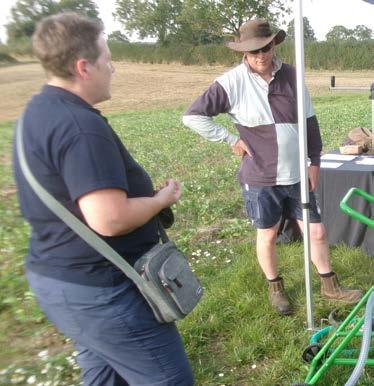
Simon Deacon, the farmer who hosted the project that Marion Perrett-Pearson oversees is a farmer keen to improve water quality from his farming operations.
Water contamination comes from several sources; overuse or inappropriate use of chemicals which get into field drains, or is run off from fields. So keeping a cover crop over potentially bare soil is good, both for protecting the bare soil and for increasing the organic matter.
One of the ways that contamination can occur is through spilled chemical, as Marion emphasized even the aluminium seal on a can of concentrate that is thrown away can cause problems. The sprayer industry are promoting and using a closed system of chemical handling which should eliminate spillage (although there is still a need to have full standardization of container caps).
Marion organised this event to which West Midland Branch members were invited and because of the location the invitation was extended to the East Midlands Branch. Also included were members of The Warwickshire Rural Hub, an organisation that publicises and organises meetings and visits of interest to Warwickshire small businesses, as many of these are farms, it is a useful organisation for anyone working or interested in agriculture in the county. Marion also invited some other farmers she knew who were interested.
We gathered in a nearby pub car park and were issued with a detailed map. As you know farms are in rural locations, this was no exception!
The particular soil improvement site we were visiting had two adjacent fields of heavy clay sloping down to a river. They had been divided into four blocks to give each a slightly different treatment.
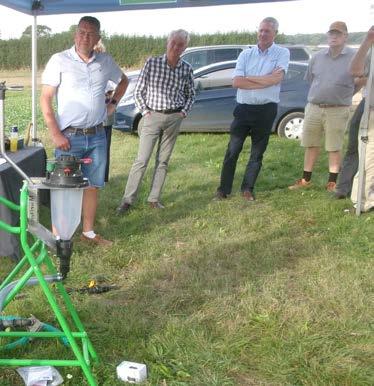
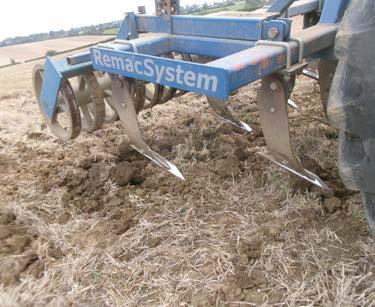
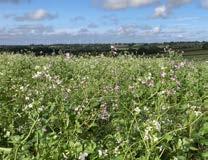
One field (plots 1 and 2) has a lot of growth. That was sown at the end of July when there was a lot of moisture in the ground. (Six weeks previously)
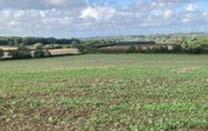
The other field (plots 3 and 4) had exactly the same herbal seed mixture but sown three weeks later in August when the ground was so much drier. This was over 4 weeks later. Within the spade hole we did find two plants and a worm.
All experiments involving farming always have the inconstancies of weather to consider.
See the two photos above.
Both photos were taken on: 21st September 2023
From previous work it is known that conventional ploughing can do a lot of harm to the earthworm population so the least disturbance the better. However, some loosening of this type of soil is important. Simon has this cultivator which loosens the soil with angled tines and follows it with a press roller to give a reasonably level field.
This was a very interesting field visit, not only to see the research that was being done but to be able to discuss at length the thought behind the variations on each trial plot and understand the reasons behind the work and learn about the problems they are trying to reduce.
The IAgrE was saddened to learn of the passing of Ken Pollock on 4th January 2024, aged 79.
A native of Beckenham in south London, Ken pursued studies in Agricultural Engineering at Newcastle, Reading and Rutgers University in New Jersey. Returning to the UK, Ken was appointed to a lecturing position in the Department of Agricultural Engineering at Newcastle University. During this time, he played a key role in interviewing and encouraging many 6th form students to develop careers in our industry. Alongside his teaching work and when he wasn’t driving his Lotus 7, Ken found time to complete his PhD on rates and application methods of animal slurries, well documented today but still little researched in the early 1970’s.
In 1977, Ken left Higher Education ‘for the bright lights’ as we teased him joining the BBC as Producer of the weekly TV Farming programme. When this morphed into Countryfile as we know it today, Ken moved sideways in the BBC to follow his passion in performance cars becoming Producer of the Top Gear motoring programme. During his tenure he recruited such well-known names as Tiff Needell and Jeremy Clarkson to the programme.
After some years at the BBC, he left
to become involved in freelance television production and on retirement became an active councillor for the Tenbury Wells ward of Worcestershire County Council. He acted as cabinet member responsible for economy and infrastructure and in this capacity was heavily involved with several major road development projects as well as the new Worcestershire Parkway Railway Station which was officially opened in 2023.
He first joined the IAgrE as an Associate member in 1969 becoming a full member in 1972 and gaining IEng registration in 1974. He thus had a 55 year association with the institution.
Despite his career taking him away from Agricultural Engineering he maintained a keen interest in the developments in technology which have taken place in our industry. Discussions with him in recent years showed that he was still very much ‘in touch’ with what was going on in the industry.
Despite being diagnosed with cancer in 2010 he remained typically positive about life and played an active role in the life of his community. Ken leaves his wife Diana and 2 daughters.

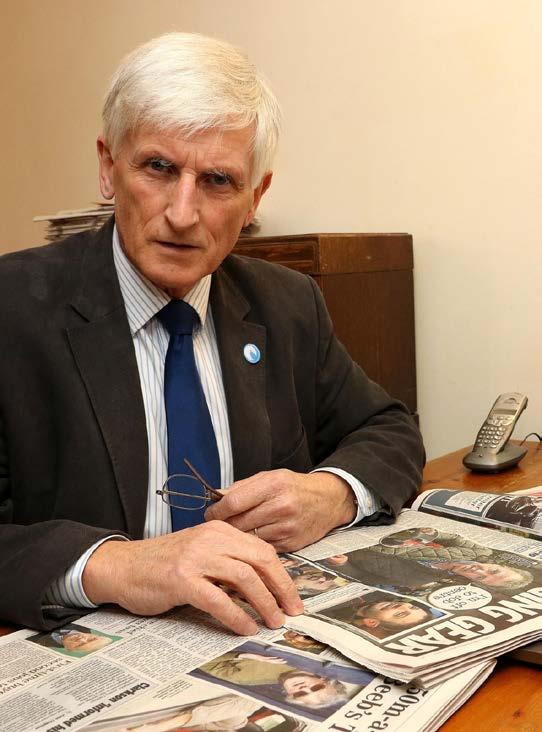
Admissions
Fellow
Member
Mr Tom Gardener (East Midlands)
Mr Luke Cloudsdale (Southern)
Mr Richard Nutt (East Anglia)
Associate Member
Affiliate
Mr James Morrish (South Africa)
Mr Jaime Hall (Southern)
Technician
Student
Harper Adams University
Myles Reay
Robert Findlay
Sebastian Wright
Jonny Hanson
Danny Wood
Thomas Martinson
Deio Rogers
Luke Tighe
Douglas Bentley
Oscar Parr
James Waller
Isaac Butland
Martin Vernon
Thomas Webb
Hannah Armstrong
Silas Jack
Charlotte Thomas
Lucy Allsop
William Davenport
William Denny
Aidan Gunson
Oliver Wade
Will Bailey
Oliver Morley
Joshua Tapner
Oliver Bailey
Percy Amiss
Theo Holley
Luke Chapman
Sion Morris
Scott Rouse
Tom Shepherdson
Freddy Harrison
Lackham Campus – Wiltshire College
Leo Fitchen
Harry Golding
Kiernan Paget
Reuben Whitcombe
Harry Bolwell
Lucy Toogood
George Deacon
Jack Nash
Ollie Vauden
Jack Wall
Terry Butler
Jack Hogan
Will Cottle
Hendrick Bruce
Ellie Horne
George Peppard
Ella Parker
Ethan Davies
Digby Freeth
Harry Burnside
George Barnes
Billy Reeves
Munster Technological University
Eoghan McGillicuddy
CAFRE
Aidan McMullan
Aaron Clarke
Conan Bradley
Timothy Millar
Matthew Wilson
George Kernaghan
Corey McKibben
Cameron Wilson
Declan Magee
Andrew Mackey
Gabrielle Logue
Joel Rea
Sean Brankin
Caleb McClean
Jack Ferris
Wade Hunter
Samuel Simpson
Michael Trainor
Harry Lyttle
Laura Gormley
Matthew Compton
Suffolk New College
James Duke
Louie Alexandrou
Readmission
Associate Member
Mr James Shaw (Western)
Mr Colin Worsley (East Midlands)
Member
Mr Lawrence Helmick (Wrekin)
Fellow
Deaths
We have recently learned of the death of the following members and we send our condolences to their family and friends:
Mr William D Hawthorn - MIAgrE
Mr Hawthorn joined the Institution at Member grade in January 2010.
Dr Kenneth A Pollock- IEng MIAgrE
Dr Pollock joined the Institution at Associate Member grade in June 1969 and transferred to Member grade in March 1972. He gained Incorporated Engineer. Registration with IAgrE in May 1974. Dr Pollock was a member of the Institution for nearly 55 years.
Fellow
Mr Angus Lindsay (Yorkshire)
Member
Mr Jonathan Bailey (Wrekin)
Associate Member
Mr Chris Todd (Northern Ireland)
Affiliate
Technician
Mr Finn Sagrott (East Anglia)
Mr Archie Penlington (East Midlands)
Mr John Gildersleeves (Southern)
EngTech
Mr James Perry (East Anglia)
Mr Joshua Fulton (Southern) CEnv
Dr Laura Cumplido-Marin (East Midlands)
Askham Bryan College
Askham Bryan, York, YO23 3FR
Berkshire College of Agriculture
Hall Place, Burchetts Green, Maidenhead, Berks, SL6 6QR
Bishop Burton College
York Road, Bishop Burton, Beverley, HU17 8QG
Brooksby Melton College
Asfordby Road, Melton Mowbray, Leics, LE13 0HJ
City College Norwich
Easton, Norwich, Norfolk, NR9 5DX
Coleg Cambria – Llysfasi
Rhuthin, Sir Ddinbych, LL15 2LB
Coleg sir Gar
Gelli Aur Campus, Llandeilo, Carmarthenshire, SA32 8NJ
Cranfield University
Cranfield, Bedfordshire, MK43 0AL
Duchy College
Stoke Climsland, Callington, Cornwall, PL17 8PB
Greenmount College
CAFRE, 22 Greenmount Road, Antrim, Northern Ireland, BT41 4PU
Harper Adams University
Newport, Shropshire, TF10 8NB
Hartpury College and University Gloucester, GL19 3BE
Lincoln Institute of Agri-Food Technology, Lincoln University, Lincoln, LN6 7TS
Manchester University
School of Electrical and Electronic Engineering, C39, Sackville Street Building, Sackville Street, Manchester, M1 3WE
Munster Technological University
Tralee Clash, Tralee, Co Kerry, Ireland
Myerscough College
Bilsbarrow, Preston, Lancashire, PR3 0RY
Newcastle University
King’s Gate, Newcastle Upon Tyne, NE1 7RU
Plumpton College
Ditchling Road, Lewes, East Sussex, BN7 3AE
Reaseheath College
Reaseheath, Nantwich, Cheshire, CW5 6DF
Royal Agricultural University
Cirencester, Gloucester, GL7 6JS
Salesian Agricultural College
Pallaskenry, Co Limerick, Ireland
Sparsholt College
Sparsholt, Winchester, SO21 2NF
SRUC – Auchincruive
Auchincruive Estate, Ayr, KA6 5HW
Suffolk New College
Suffolk Rural Campus, Charity Lane, Otley, Suffolk, IP6 9EY
University of Manitoba
Winnipeg, Canada, MB R3T 2N2
Warwickshire College Group
Warwick New Road, Leamington Spa, CV32 5JE
Wiltshire College Lackham
Lacock, Chippenham, Wiltshire, SN15 2NY
Writtle University College
Lordship Road ,Writtle, Chelmsford, Essex, CM1 3RR
Notice is hereby given that the Seventy-eighth Annual General Meeting of the Institution will be held on Wednesday 17th April 2024 at 12noon online via Zoom
Agenda
1. To receive and consider the minutes of the seventy-seventh AGM held on 26th April 2023 online
2. To propose as an Ordinary Resolution:
“That the Annual General Meeting authorises the Trustees of the Institution to review members’ subscriptions and to make such adjustment, if any, as may be required with effect from 1st January 2025”.
3. To receive and consider the Annual Report for the year ending 31st December 2023.
4. To receive and consider the Accounts for the ending 31st December 2023.
5. To announce nominations for election to Council for the 2024/25 Session.
6. To re-appoint Landers Accountants Ltd, registered auditors, as reporting accountants and to authorise the Executive to fix their remuneration
By Order of the Trustees
Charles Nicklin, Chief Executive and Secretary 28th February 2024
NB ALL PAPERS WILL BE AVAILABLE ON THE IAGRE WEBSITE
Ace Aquatec Ltd
16B City Quay, Camperdown Street, Dundee, DD1 3JA
Agri-EPI Centre
Easter Bush, Roslin, EH25 9RG
Alois POTTINGER UK Ltd
15 St Marks Road, Corby, Northampton, Northants, NN18 8AN
Agricultural Engineers Association (AEA)
Samuelson House, 62 Forder Way, Hampton, Peterborough, PE7 8JB
AGCO Ltd
Stoneleigh, Abbey Park, Kenilworth, Warwickshire, CV8 2TQ
Alvan Blanch Development Co
Chelworth, Malmesbury, Wiltshire, SN16 9SG
Amazone Ltd
Orchard Farm, Hurst Lane, Aukley, Doncaster, South Yorks, DN9 3NW
Autoguide Equipment Ltd
Stockley Road, Hedington, Calne, Wiltshire, SN11 0PS
BAGMA
225 Bristol Road, Birmingham, B5 7UB
Case New Holland
Cranes Farm Road, Basildon, Essex SS14 3AD
City and Guilds
1 Giltspur Street, London, EC1A 9DD
City Farm Systems Ltd
25 Hepplewhite Close, High Wycombe, Bucks, HP13 6BZ
Claas UK Ltd
Saxham, Bury St Edmonds, Suffolk, IP28 6QZ
David Ritchie (Implements) Ltd
Carseview Road, Suttieside, Forfar, Angus, DD8 3EE
Douglas Bomford Trust
The Bullock Building, University Way, Cranfield, Bedford, MK34 0GH
DSL Systems
Adbolton Hall, Adbolton Lane, West Bridgford, Nottingham, NG2 5AS
Fullwood
Grange Road, Ellesmere, Cheshire, SY12 9DF
Househam Sprayers
Roughton Moor, Woodhall Spa, Lincs, LN10 6YQ
HSS Hire
Building 2, Think Park, Mosley Road, Manchester M17 1FQ
John Deere Ltd
Harby Road, Langar, Nottinghamshire, NG13 9HT
Knight Farm Machinery
Wireless Hill Industrial Estate, South Luffenham, Rutland, Leicestershire, LE15 8NF
Kubota UK Ltd
Dormer Road, Thame, Oxfordshire. OX9 3UN
Magna Specialist Confectioners Ltd
Magna House, Stafford Park 3, Telford, Shropshire, TF3 3BH
Marks & Clerk LLP
90 Long Acre, London, WC2E 9RA
Mastenbroek Ltd
83 Swineshead Road, Boston, Lincs, PE21 7JG
Merlo UK Ltd
The Paddocks, Headlands Business Park, Salisbury Road, Ringwood, Hampshire BH24 3PB
National Fluid Power Centre
Carlton Road, Worksop, Notts, S81 7HP
NFU Energy Services
Stoneleigh Park, Kenilworth, Warwickshire, CV8 2LS
Nick Young Tractor Parts
Unit 2, The Forge, Moor Road, North Owersby, Market Rasen, Lincolnshire, LN8 3PR
Ploeger UK Ltd
Holt Road, Fakenham, Norfolk, NR21 8JH
Reesink UK Limited
1-3 Station Road, St Neots, Huntingdon, PE19 1QF
Shelbourne Reynolds
Shepherds Grove Ind Estate, Stanton, Bury St Edmunds, Suffolk, IP31 2AR
Spaldings Limited
25-35 Sadler Road, Lincoln, Lincolnshire, LN6 3XJ
Spraying Systems Ltd
Headley House, Headley Road, Hindhead, Surrey, GU26 6UK
Teagle Ltd
Blackwater,Truro, Cornwall, TR4 8HQ
Witham Oil and Paint Ltd
Outer Circle Road, Lincoln, LN10 6YQ

New biotechnology to remove phosphorus from wastewater given funding
A novel bio-based process able to remove and recover phosphorus from wastewater – developed by Cranfield University experts – has won almost half a million pounds of funding from OFWAT.

The Water Discovery Challenge – which aims to accelerate the discovery, development and adoption of promising new innovations for the water sector – will see 10 innovators share up to £4.5 million to solve some of the biggest challenges facing the water sector.
Cranfield University has developed a new technology which uses bacteria to remove phosphorus from water
Cranfield University – alongside US-based biotechnology company Microvi – has developed a new technology which uses bacteria to remove phosphorus from water without the need for coagulants.
Currently the water industry uses metal-based coagulants to remove phosphorus but the new
bio-mineral phosphorus removal (BMPR) process does not use them, and it also helps to recover nutrients as re-usable salts. The long-term goal of the research is to commercialise the technology to save money, decrease environmental impacts of nutrient management whilst meeting environmental goals.

The bacteria used in new bio-mineral phosphorus removal (BMPR) process doesn’t currently exist in wastewater systems, but Microvi has developed engineered biocatalysts which enables the selected bacteria to stay within the wastewater so that it can be effectively introduced.
Phosphorus is both a pollutant and a resource, but using coagulants to remove it from wastewater can be expensive as well as problematic because of supply chain risks, while it also introduces additional chemicals into the water cycle.
Initial tests completed at Cranfield university using the BMPR
technology shows a 96% removal of phosphorus from wastewater from a range of initial concentrations from 4 to 80 mg/L. This is the same result as if using traditional coagulants.
Ana Soares, Professor of Biotechnology Engineering at Cranfield University, said: “Our approach not only addresses the pressing issue of phosphorus pollution in wastewater but also offers a sustainable solution by exploiting the amazing beneficial potential of bacteria without relying on traditional coagulants and enables to recover a finite resource that is phosphorus.
said: “This competition was about reaching new innovators from outside the sector with different approaches and new ideas, and that’s exactly what the winners announced today are doing.
“The products and ideas recognised in this cross-sector challenge will equip water companies to better face challenges of the future –including achieving sustainability goals and meeting net zero targets –all while providing the highest-quality water for consumers.”
“This funding will enable us to accelerate the commercialisation of our technology, ultimately benefiting both the water industry and the environment.”

Major project to work with peat farmers to develop ways to boost habitats and ecosystems
A major project will see Harper Adams University academics working with Shropshire farmers who farm on peat to develop ways to boost habitats and ecosystems while maintaining food production.
The Patchy Peat Solutions project, which has received a grant of £494,073, will work with five farmers across the county as well as utilising the Harper Adams Future Farm.
It is one of 13 projects across England which make up the Lowland agricultural peat water discovery pilot. The £3.1 million pilot, funded by the UK Government, will use local partnerships to understand how water can be better managed to rewet and preserve peat soils – with costed water plans being drawn up as a result of the collaborations.
Participating farmers who farm on peat on their farms across the county will be at the core of the Patchy Peat Solutions project consortium.
They will work with Harper Adams academics including Dr Casperd,
Dr Casperd said: “We will be working with a variety of industry stakeholders during this year-long project which will explore a number of critical threads relating to agricultural sustainability, habitat restoration and habitat creation.
“These include the monetisation of the natural capital each farm holds, and the management of water resources and carbon stocks.
“We want to know how this peaty land could be managed as a mosaic with conventional farming in a better, more sustainable way to support biodiversity, mitigate greenhouse gas emissions and climate changewithout negatively impacting on the UK’s food production.”
The project is part of the Lowland Agricultural Peat Water Discovery Pilot funded by the Environment Agency and Defra. It is one of several underway at Harper Adams as the University seeks to extend its research in paludiculture – the practice of farming on wet peat.
England’s peat soils are highly productive with three-quarters of the lowland peat in England used for farming.
However, as peatland is drained and cultivated for farming, the peat oxidises, leading to organic matter in the soils decomposing – which generates increased greenhouse gas (GHG) emissions.
Re-wetting peat has the potential to reduce these emissions, keeping carbon in the soil.
However, there is much that is yet to be understood about the science and practice of farming on peat following re-wetting – hence the University’s research.
This team will be working with a wider consortium including precision agriculture specialist Clive Blacker, consultant hydrogeologist Rob Low, Downforce Technologies, Professor Fred Worral from Durham University, Kate Mayne of the Strine Internal Drainage Board, Shropshire Wildlife Trust, Biodiversity Net Gain specialist Ricardo Gutierrez-Inostroza, Legacy Habitat Banks, and Aqualate Castle Holdings.

Rothamsted part of consortium awarded £6.5m to establish a land use for net zero hub
34 organisations will together provide UK administrations with evidence to drive land transformation to Net Zero by 2050.
A first of its kind consortium of 34 leading research and stakeholder organisations has been established to help all four UK administrations address land use and agriculture as a major greenhouse gas emitting sector.
Announced recently the “Land Use for Net Zero” (LUNZ) Hub, co-led by The James Hutton Institute and the University of Leicester, with £6.5
million funding from UK Research and Innovation, will provide UK and devolved nations timely evidence around land use, from renewable energy to soil carbon and green finance, to help drive the land transformations needed to achieve net zero by 2050.
It will also play a pivotal role in helping to communicate more widely the critical importance of land and how it’s used as a major carbon sink or source.
Professor Adie Collins, Rothamsted’s head of Net Zero and Resilient Farming, welcomed the announcement and added, “As our contribution to the Hub, Rothamsted will be co-leading (with RSK ADAS) work on agricultural systems, specifically looking to develop and
apply a viability indicator to help the selection and prioritisation of interventions and technologies for net zero transitions for different farm types.”
Agriculture and land use have a major impact on greenhouse gas (GHG) emissions, as well as a wide range of other environmental, societal and economic outcomes, but progress towards decarbonisation is lagging behind other sectors.
The declaration recently announced at COP28 on sustainable agriculture, resilient food systems and climate action states the UK government’s intent to act on land use and climate change by increasing public financial support and scaling science-based solutions, and LUNZ will be a key conduit for these actions.
The first day of the EPSRC Hydrogen Hubs Launch event was dedicated to a public unveiling and celebration of the UK Hub for Research Challenges in Hydrogen and Alternative Liquid Fuels (UK-HyRES) and the Hydrogen Innovation for Accelerated Energy Transitions Hub (HI-ACT). It was a day filled with insights, discussions, and a shared vision for the future of hydrogen in the UK.
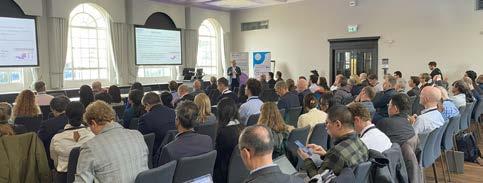
Dr. Dawei Wu, (HI-ACT Co-I, University of Birmingham), extended a warm welcome to Birmingham.
Prof. Sara Walker (HI-ACT Director) and Prof. Tim Mays (UK-HyRES Director), representing the hubs, followed with their greetings and thanked everyone for their contributions to this point.
Councillor Lisa Trickett from Birmingham City Council delivered a keynote address, highlighting the importance of hydrogen in sustainable urban development and emphasising the need for a just transition that addresses fuel poverty.
The next session featured an overview of HI-ACT by Prof. Jianzhong Wu (HI-ACT Co-Director, Cardiff University). UK-HyRES was positioned by Prof. Rachael Rothman, UK-HyRES Co-Director at the University of Sheffield, who delved into our unique Hub structure and large, accessible, flexible fund (>£4M). Prof. Rothman discussed our journey so far and the ways for stakeholders to not only engage, but actively shape research that delivers
impact. The audience also had the privilege of viewing a video message from The Rt Hon Chris Skidmore OBE MP, who stressed the importance of taking people along on the journey to net zero and the need for agility and flexibility as strategic drivers for change.
The plenary session introduced the Joint Scientific Advisory Board (SAB), co-chaired by Rita Wadey and Prof. David Grant (Energy Institute Director, University of Nottingham). The session also included fantastic presentations by Prof. Henry Tse on the opportunities that the Hydrogen Innovation Initiative (HII) partnership offers and Dr. Allan Simpson of Equilibrion discussed the role of Nuclear Enabled Hydrogen, who remarked, “It’s time to diversify our thinking”.
A panel discussion on “Hydrogen and Alternative Liquid Fuels in a Net Zero Economy,” moderated by Celia Greaves, featured industry experts: Bethan Winter – Wales & West Utilities – System Operations Manager, Prof Xiaohong Li –
University of Exeter – Professor of Renewable Energy, Dr Mark Bankhead – National Nuclear Laboratory – Technology Manager Hydrogen and Helen McColm –Department for Energy Security and Net Zero – Joint Head of Hydrogen Theme.
The day concluded with engaging discussions in the “Hydrogen Futures – Meet the Investigators” session, where attendees explored future research opportunities and priorities for the hubs. It was an enriching day filled with knowledge sharing and networking, marked by a shared commitment to a sustainable future.
Both days of the EPSRC Hydrogen Hubs Launch event were marked by collaboration, knowledge sharing, and a shared commitment to advancing hydrogen and alternative liquid fuels research for a sustainable future. The event served as a vital stepping stone towards achieving the goals of the Hydrogen Hubs and their mission to drive innovation in the hydrogen sector.
Have you considered professional membership and registration for your employees?
This not only supports their personal development, but also demonstrates your professionalism as a business.


How do my employees join?
It couldn’t be easier, visit www.iagre.org/why-join-iagre or contact Alison Chapman at membership@iagre.org or call us on01234 750876 and we’ll happily guide you.